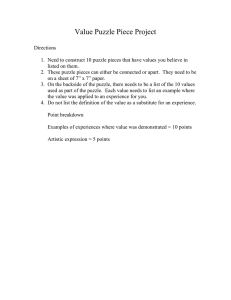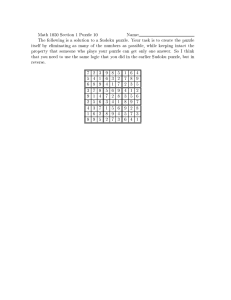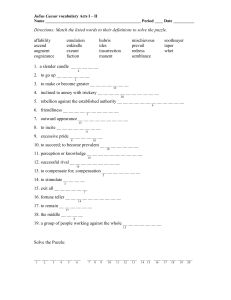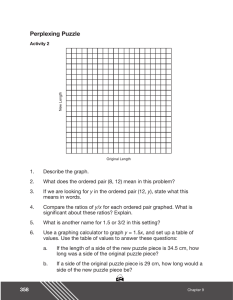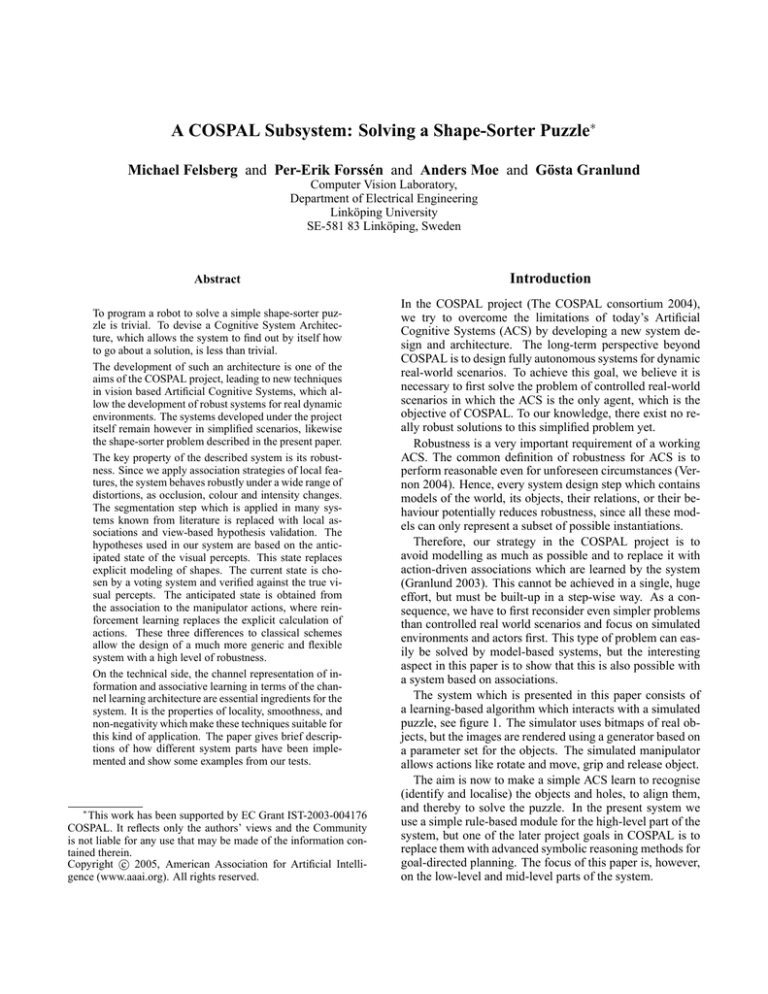
A COSPAL Subsystem: Solving a Shape-Sorter Puzzle∗
Michael Felsberg and Per-Erik Forssén and Anders Moe and Gösta Granlund
Computer Vision Laboratory,
Department of Electrical Engineering
Linköping University
SE-581 83 Linköping, Sweden
Abstract
To program a robot to solve a simple shape-sorter puzzle is trivial. To devise a Cognitive System Architecture, which allows the system to find out by itself how
to go about a solution, is less than trivial.
The development of such an architecture is one of the
aims of the COSPAL project, leading to new techniques
in vision based Artificial Cognitive Systems, which allow the development of robust systems for real dynamic
environments. The systems developed under the project
itself remain however in simplified scenarios, likewise
the shape-sorter problem described in the present paper.
The key property of the described system is its robustness. Since we apply association strategies of local features, the system behaves robustly under a wide range of
distortions, as occlusion, colour and intensity changes.
The segmentation step which is applied in many systems known from literature is replaced with local associations and view-based hypothesis validation. The
hypotheses used in our system are based on the anticipated state of the visual percepts. This state replaces
explicit modeling of shapes. The current state is chosen by a voting system and verified against the true visual percepts. The anticipated state is obtained from
the association to the manipulator actions, where reinforcement learning replaces the explicit calculation of
actions. These three differences to classical schemes
allow the design of a much more generic and flexible
system with a high level of robustness.
On the technical side, the channel representation of information and associative learning in terms of the channel learning architecture are essential ingredients for the
system. It is the properties of locality, smoothness, and
non-negativity which make these techniques suitable for
this kind of application. The paper gives brief descriptions of how different system parts have been implemented and show some examples from our tests.
∗
This work has been supported by EC Grant IST-2003-004176
COSPAL. It reflects only the authors’ views and the Community
is not liable for any use that may be made of the information contained therein.
c 2005, American Association for Artificial IntelliCopyright gence (www.aaai.org). All rights reserved.
Introduction
In the COSPAL project (The COSPAL consortium 2004),
we try to overcome the limitations of today’s Artificial
Cognitive Systems (ACS) by developing a new system design and architecture. The long-term perspective beyond
COSPAL is to design fully autonomous systems for dynamic
real-world scenarios. To achieve this goal, we believe it is
necessary to first solve the problem of controlled real-world
scenarios in which the ACS is the only agent, which is the
objective of COSPAL. To our knowledge, there exist no really robust solutions to this simplified problem yet.
Robustness is a very important requirement of a working
ACS. The common definition of robustness for ACS is to
perform reasonable even for unforeseen circumstances (Vernon 2004). Hence, every system design step which contains
models of the world, its objects, their relations, or their behaviour potentially reduces robustness, since all these models can only represent a subset of possible instantiations.
Therefore, our strategy in the COSPAL project is to
avoid modelling as much as possible and to replace it with
action-driven associations which are learned by the system
(Granlund 2003). This cannot be achieved in a single, huge
effort, but must be built-up in a step-wise way. As a consequence, we have to first reconsider even simpler problems
than controlled real world scenarios and focus on simulated
environments and actors first. This type of problem can easily be solved by model-based systems, but the interesting
aspect in this paper is to show that this is also possible with
a system based on associations.
The system which is presented in this paper consists of
a learning-based algorithm which interacts with a simulated
puzzle, see figure 1. The simulator uses bitmaps of real objects, but the images are rendered using a generator based on
a parameter set for the objects. The simulated manipulator
allows actions like rotate and move, grip and release object.
The aim is now to make a simple ACS learn to recognise
(identify and localise) the objects and holes, to align them,
and thereby to solve the puzzle. In the present system we
use a simple rule-based module for the high-level part of the
system, but one of the later project goals in COSPAL is to
replace them with advanced symbolic reasoning methods for
goal-directed planning. The focus of this paper is, however,
on the low-level and mid-level parts of the system.
B1
50
Predict manipulator
appearance
100
Move manipulator
Fail
Success
150
Learn manipulator
appearance
200
B2
250
300
Move to interesting
position
50
100
150
200
250
300
350
Try to grip object
400
Fail
Update
interest map
Figure 1: Image from puzzle simulator. The object at the
top, centre is the manipulator.
B3
A Simple COSPAL System
The system currently has four different behaviours, which
are innate, or hard-wired. For later instances of the system
we plan to replace these schemes to a large extent with symbolic learning. For the current implementation, the four behavioral schemes are:
B1 learn manipulator-action-appearance map
B2 find object
B3 learn object appearance
B4 align objects.
The system learns about its environment in behaviours B1B3, and applies the acquired knowledge in B4. As it can
be seen from the state graph in figure 2, behaviours B1B3 have a common structure which establishes a actionperception/prediction-learning (APL) loop.
The top three boxes constitute B1. In this behaviour, the
system learns to predict how the appearance of the manipulator changes as it is moved. This allows the system to find
out what parts of the scene constitute the manipulator, and
then avoid its attention to be drawn to it.
The three boxes in the middle of figure 2 below form B2.
This is essentially an attention switching mechanism, which
moves the manipulator between potentially interesting (not
recognised) locations.
The three boxes at the bottom form B3, in which the system learns how an object changes appearance by manipulating it. After the system has run out of new objects to explore
it switches to B4, and solves the puzzle.
Figure 3 illustrates the first part of the recognition system
from a computational view. The 2D puzzle generator renders puzzle images and if in learning mode, it also provides
the current parameters of the manipulator. This is how the
system learns to predict the manipulator appearance. Learning of object appearances is done in a similar way, with the
notable exception that no object parameters are provided by
the simulator. We will in the following sections describe the
system in more detail.
Interest Points and Orientation Maps
From the rendered images, the system extracts local interest
points (IP) or foci of attention for the recognition step. In
Success
Success
Predict object
appearance
Move object
Fail
Learn object
appearance
Figure 2: State graph for COSPAL system behaviour.
2D puzzle generator
provides
renders
puzzle images
manipulator parameters
extract
difference image
compute
encode
center of gravity
div!features
select
orientation maps
response channel u
learning
mode
C1 = opt(a, u)
operation
mode
u = C1 a
linkage matrix C1
encode
feature channel a
Figure 3: Recognition part 1 of our COSPAL subsystem.
The grey boxes preprocess the visual percepts and are different for different levels of the system. Note further that
for B2 no optimization is performed in our implementation.
Instead, the interest map is multiplied with a decay field.
the present implementation we use local maxima of a first
order rotational symmetry map, i.e., div-features (Johansson
& Granlund 2000), and the map’s direction at the maxima.
1
50
100
0
150
c0
c1
c2
c3
c4
c5
c6
c7
c8 feature
200
Figure 6: Channel encoding: Projection of the value c4 onto
non-negative, smooth, and compact functions (grey).
250
300
50
100
150
200
250
300
350
400
Figure 4: Directed interest points from figure 1. Square at
lower centre of image is an example of a local patch.
2
5
5
5
5
4
10
10
10
10
6
15
15
15
5
8
10
15
5
10
15
15
5
10
15
5
10
15
5
10
15
10
12
5
5
5
5
14
10
10
10
10
15
16
2
4
6
8
10
12
14
16
15
5
10
15
15
5
10
15
15
5
10
15
Figure 5: Local orientation patch corresponding to the patch
in figure 4. Left: Local orientation patch centred in div point
and oriented according to div direction. Each position in the
patch is a complex value, z. Here |z| is mapped to luminance, and arg z is mapped to different colours. Right: The
eight channels of the channel encoded patch.
The IP detector can be realised in other ways as well but
some local direction at the IP is required for the later steps.
The requirement of a local direction at the IP is also fulfilled
by e.g. SIFT-features (Lowe 2004). For an example of directed interest points, see figure 4.
Around each IP a local orientation image patch is extracted. The patches are extracted in a local coordinate system, centred in the IP, and oriented according to the IP direction. This method results in a feature map which is invariant
to rotation. See figure 5 for an example of an extracted orientation patch.
Channel Representation
The orientation of each element in the patches is channel
encoded (Granlund 2000) giving a sparse monopolar feature
vector. Channel encoding means to project the value of a
measurement onto non-negative, compact, and smooth basis
functions in the co-domain (here: orientation), see figure 6.
The projection coefficients ck form a vector, the channel
vector. The channel vectors are then weighted with the magnitudes of the orientation estimates. With a 16 × 16 patch
and 24 channels, this gives 16 × 16 × 24 = 6144 element
long feature vector, a. See figure 5 (right) for an example of
a channel encoded local orientation patch.
Obtaining a Response Vector
During training of the linkage matrix (Granlund 2000) C1 ,
we also need to specify a desired response u, see figure 3.
We want u to describe the type, location and orientation of
the object that a feature patch belongs to.
When the system enters behaviour B3, it has an object in
the manipulator, it just does not know what it is yet. It proceeds by moving the object, and releasing it. The system
then tries to recognise the object in its new location. If successful, the system leaves the object and switches to B2. If,
on the other hand, the system fails to recognise the object, it
observes what parts of the scene changed when moving the
object, and generates a change mask. This is quite similar
to the approach of Fitzpatrick (Metta & Fitzpatrick 2003),
where objects are prodded in order to obtain a figure-ground
segmentation. From the change mask, the system extracts
an object centre, defines the object orientation as zero, and
also defines a new object type. For all interest points(IP)
falling inside the change mask, we define a desired response
u, from the new object type, object centre and object orientation, the latter two in the coordinate system of the IP.
During operation, all features (extracted around the IPs)
are considered and channel encoded. It is the localised structure of the linkage matrix C1 which leads to an implicit segmentation of the input, depending on the respectively associated features.
Learning Algorithm
The feature vectors a are associated with a response vector
u, representing the object type, orientation and centre in the
IP’s coordinate system. In operation mode the association
is formed through an associative network u = C1 a. For
each IP, the orientation and position are channel encoded.
With 18 channels for each position coordinate, 8 channels
for orientation and 6 different objects, this gives (18 + 18) ×
8 × 6 = 1728 response channels.
The associative network is trained by a non-negative leastsquares optimisation. Given a set of corresponding feature
vectors a and response vectors u collected in form of column vector matrices A and U, the optimisation problem
Channel Reinforcement Learning of Movements
puzzle image
object’s coordinates
The mapping between the control signals to the manipulator and the manipulator’s movements in the image is learned
using reinforcement learning (Sutton & Barto 1998). As update rule, we use the channel reinforcement technique described in (Borga 1998). Three mappings are learned: movement direction, distance, and rotation. The inputs are direction to the point to move to, distance to the point and desired
rotation. The direction and distance mappings are rewarded
based on the distance change to target point x∗ :
extract
decoding
orientation map o
learning
mode
C2 = opt(u, o)
response channel u
m = s|o
∆d = ||x0 − x∗ || − ||x − x∗ || .
linkage matrix C2
operation
mode
s = C2 u
(4)
The rotation maping is rewarded based on the orientation
error change, with respect to the target direction φ∗ :
predicted shape s
∗
∗
∆d = | arg eiφ0 −iφ | − | arg eiφ−iφ | .
Figure 7: Recognition part 2 of our system. The predicted
shape is represented by channel vector s, the local orientation map by channel vector o. In B2, the associative network
is replaced with a direct percept of gripping success.
min kU − C1 Ak2 .
C1 ≥0
(1)
We will not go into further detail about the optimisation itself, the reader is referred to (Johansson 2004).
Shape Prediction and Verification
The response vectors u of the network C1 are not directly
used for recognition. Instead the decoded responses are verified by predicting a channel encoded orientation patch in
the object’s coordinate system, using a second associative
network C2 , see figure 7.
With 6 objects and a 16 × 16 × 8 orientation patch, this
gives a linkage matrix C2 , of size 2048 × 6. The prediction
s is used to verify the hypothesis of object position, orientation and type, given by decodings from u, by computing
a match score m between the predicted orientation patch o,
and what is present in the image at the predicted position.
Voting and Hypothesis Combination
The responses u from the first network at each interest point
are decoded and transformed to a global coordinate system,
where they are again channel encoded, and weighted with
the match score for the predicted shape. Since linear transformations can be performed directly in the channel representation (Felsberg, Scharr, & Forssén 2002), we symbolise
the new channel vector as
v = mT(u) .
(2)
The resultant responses vk are then summed over all IPs k.
The recognition result is finally obtained as a point in the
4-D space of object type, position, and orientation, which is
the channel decoding result from
k=1
vk =
K
X
k=1
mk Tk (uk ) =
We define the reward for all mappings as:
r = 1 + α|∆d|∆d ,
(6)
where α is a tuning parameter.
Alignment
reads (Johansson 2004)
K
X
(5)
K
X
k=1
hsk |ok iTk (uk ) .
(3)
The last behaviour, B4, is purely rule-based and is going to
be replaced with more advanced techniques in the future.
The object alignment is done by trying to pick up an object
on the position with highest confidence, i.e., the strongest
mode of v. If the “pick up” action succeeds, the system
moves the gripped object to the position with the second
highest confidence with the same object type. It then aligns
the orientations of the objects and then releases the object
in the manipulator. If the system fails to grip the object it
reverses the order, i.e., it tries to grip the same object type
with the weaker confidence. This is done until all objects
have been moved.
Experiments
Once the system has been trained, it can be used to solve
puzzle problems generated by the puzzle generator. One of
these problems and its solution sequence is documented in
figure 8.
The system starts with selecting one object (the circle)
and moves it to the corresponding hole, see figure 8 a. The
system then selects the arch, which cannot be put into the
corresponding hole, since it is occluded by the square, see
figure 8 b. The system puts the arch back to its original position and continues with another object. After the triangle
and the semi-circle, the system selects the square, such that
the occlusion of the arch-hole is removed, see figure 8 c. Finally, the arch is put in the correct hole and the puzzle is
solved, see figure 8 d.
Conclusion
It turned out that the described, simple sequence of feature
associations, view based hypothesis validations, and voting
lead to a robust object recognition technique which does not
require a prior segmentation. The method is robust under
occlusion and many changes of appearance (e.g., colour, intensity). Since our approach does not depend on particular
a: ordinary situation
models, we can apply it to totally different 2D settings without rewriting modules. It is just the linkage matrices which
have to be relearned or extended.
For the future we hope to be able to extend the method to
3D scenarios without structural changes in the method, i.e.,
we replace feature spaces with higher dimensional ones, but
we need not redesign the data-flow and interdependencies.
To reach the goal of a full-fledged COSPAL system the
difficult steps to physical embodiment and to integration of
symbolic learning and reasoning instead of hard-wired behavioral schemes have to be made. We believe that the regular APL structure of our predefined behaviors can also serve
as a generating pattern for higher levels of the system and
that by symbolic learning new and higher level capabilities
can be generated. Without such capabilities, the system will
always have to behave according to the prescribed patterns.
References
b: conflict
c: solving conflict
d: finished
Figure 8: Solving the puzzle.
Borga, M. 1998. Learning Multidimensional Signal Processing. Ph.D. Dissertation, Linköping University, Sweden, SE-581 83 Linköping, Sweden. Dissertation No 531,
ISBN 91-7219-202-X.
Felsberg, M.; Scharr, H.; and Forssén, P.-E. 2002. The Bspline channel representation: Channel algebra and channel based diffusion filtering. Technical Report LiTHISY-R-2461, Dept. EE, Linköping University, SE-581 83
Linköping, Sweden.
Granlund, G. H. 2000. An Associative Perception-Action
Structure Using a Localized Space Variant Information
Representation. In Proceedings of Algebraic Frames for
the Perception-Action Cycle (AFPAC).
Granlund, G. 2003. Organization of Architectures for
Cognitive Vision Systems. In Proceedings of Workshop on
Cognitive Vision.
Johansson, B., and Granlund, G. 2000. Fast selective detection of rotational symmetries using normalized inhibition. In Proceedings of the 6th European Conference on
Computer Vision, volume I, 871–887.
Johansson, B. 2004. Low Level Operations and Learning
in Computer Vision. Ph.D. Dissertation, Linköping University, Sweden, SE-581 83 Linköping, Sweden. Dissertation
No. 912, ISBN 91-85295-93-0.
Lowe, D. 2004. Distinctive image features from scaleinvariant keypoints. International Journal of Computer Vision 60(2):91–110.
Metta, G., and Fitzpatrick, P. 2003. Early integration of
vision and manipulation. Adaptive Behavior 11(2):109–
128.
Sutton, R. S., and Barto, A. G. 1998. Reinforcement Learning, An Introduction. Cambridge, Massachusetts: MIT
Press. ISBN 0-262-19398-1.
The COSPAL consortium. 2004. Cospal project. http:
//www.cospal.org.
Vernon, D. 2004. Cognitive vision – the development of a discipline.
http://europa.eu.int/
information society/istevent/2004/cf/
document.cfm?doc id=568.

